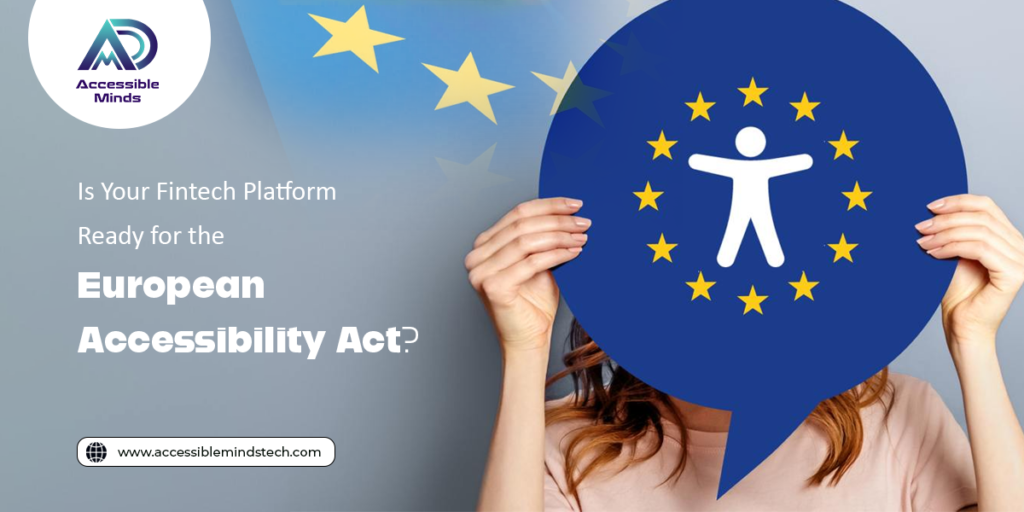The European Accessibility Act (EAA), set to be enforced in June 2025, marks a major shift in how digital products and services must be designed and delivered across the EU. If you’re operating a fintech platform—whether in payments, banking, lending, or insurance—compliance is no longer optional. The EAA mandates that services be accessible to all users, including people with disabilities. For fintech firms, this requires more than good intent—it demands strategic action backed by digital accessibility services.
Understanding the European Accessibility Act
The EAA (Directive EU 2019/882) is a legally binding initiative that ensures digital accessibility across a range of services and products in the EU. It covers areas such as:
- Banking and financial services (including fintech apps)
- E-commerce websites and mobile apps
- ATMs and payment terminals
- Digital documentation such as PDFs and statements
Any B2C fintech company that provides digital services in the EU must ensure its platforms are accessible, whether hosted in the EU or not. That means both web platforms and mobile applications must comply with standards such as EN 301 549 and WCAG 2.1 AA.
Why Accessibility Matters in Fintech
Digital financial services are essential infrastructure today. Millions rely on mobile banking apps, digital wallets, and investment platforms as their primary financial interface. Yet, for users with visual, auditory, cognitive, or motor impairments, accessing these services can be unnecessarily difficult—or even impossible—without proper accessibility features.
Failing to provide accessible financial services is not just non-compliance—it’s digital exclusion. In an age where financial inclusion is a global goal, accessibility is key to:
- Expanding your user base
- Building brand trust
- Avoiding legal penalties
- Enhancing usability for all
Key Compliance Requirements for Fintech Platforms
To meet the EAA’s expectations, fintech platforms need to consider both technical and design-level accessibility across all digital touchpoints. Here’s a breakdown of what this involves:
1. Website and App Accessibility
- All public-facing content must be perceivable, operable, understandable, and robust (the four WCAG principles).
- Use of screen reader–friendly layouts and semantic HTML.
- Accessible navigation (keyboard-only access, voice commands).
- Sufficient color contrast and resizable text options.
2. Accessible Forms and Inputs
- All input fields (e.g., login, payment, onboarding) must be correctly labeled and navigable.
- Error messages must be clear and programmatically associated with form fields.
3. Documentation and Statements
- Monthly statements, T&Cs, and product disclosures must be available in accessible formats such as tagged PDFs or accessible HTML versions.
4. Video and Multimedia
- Promotional or tutorial videos must include captions, audio descriptions, or transcripts.
5. Assistive Technology Compatibility
- Your platform must work with screen readers, Braille displays, speech input software, and other assistive technologies.
The Role of Digital Accessibility Services
Complying with the EAA isn’t a one-time task—it’s an ongoing commitment. This is where digital accessibility services come into play.
These services are designed to help companies audit, implement, and maintain digital experiences that are inclusive and standards-compliant. Here’s how they can help fintech firms prepare for the EAA:
a) Accessibility Audits
Professionally conducted audits evaluate your current platform against WCAG 2.2 and EN 301 549. They uncover gaps such as missing alt text, inaccessible form fields, or poor keyboard navigation.
b) Remediation Support
Once gaps are identified, accessibility experts can work alongside your dev team to remediate issues with minimal disruption. This includes optimizing code, reworking UI/UX, and applying ARIA labels where necessary.
c) Design Accessibility
Digital accessibility services often include accessible design practices—color palettes, typography, and layout components that ensure usability for all, including those with vision or motor impairments.
d) Ongoing Monitoring
Fintech platforms constantly evolve. Accessibility services provide automated testing tools and manual validation to ensure continued compliance as your platform changes.
e) Training and Enablement
Your in-house designers, developers, and QA teams need to understand accessibility basics. Digital accessibility partners offer tailored workshops and documentation to embed accessibility into your development lifecycle.
Strategic Advantages of Prioritizing Accessibility
While the European Accessibility Act makes compliance mandatory, the benefits go far beyond legal requirements. By engaging professional digital accessibility services, your fintech brand gains:
- Wider market reach: Cater to over 100 million EU citizens with disabilities.
- Improved user experience: Accessibility often leads to cleaner, more intuitive interfaces.
- SEO benefits: Accessible design improves site structure and performance.
- Risk reduction: Avoid costly fines, reputational damage, or legal disputes.
- Investor confidence: ESG-conscious investors now consider digital inclusivity a key factor.
Final Thoughts: Prepare Now, Don’t Wait for Deadlines
Preparing your fintech platform for the European Accessibility Act takes time. From initial audits to code-level remediations and inclusive design, compliance requires a deliberate, cross-functional effort. Whether you’re a startup scaling quickly or an established player in the European market, investing in digital accessibility services now will help future-proof your platform and position your brand as an inclusive leader in the financial sector.
Accessibility isn’t just a checkbox—it’s an opportunity. One that ensures every user, regardless of ability, can access the financial tools they need to live, work, and thrive.
Need help making your fintech platform EAA-ready?
Partner with experienced digital accessibility service providers and start your compliance journey today.

